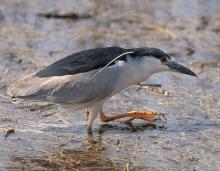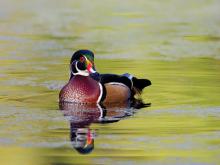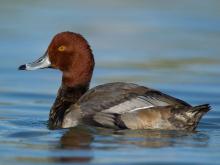Birds
Media

Species Types
Scientific Name
Nyctanassa violacea
Description
Adult yellow-crowned night-herons have black heads with creamy white cheek patches and crown. Night-herons are named for their habit of foraging mostly in the evening.
Media

Species Types
Scientific Name
Nycticorax nycticorax
Description
Stocky and short-legged compared to other herons, the black-crowned night-heron has a black crown and back, gray wings, and whitish-gray underparts and head.
Media

Species Types
Scientific Name
Buteo lineatus
Description
The red-shouldered hawk is associated with forests and near water, in places where the lower part of the forest canopy is fairly open. They sit on tree branches and watch for movement on the ground.
Media

Species Types
Scientific Name
Bucephala clangula
Description
The common goldeneye is a common migrant and winter resident in Missouri. A diving duck, it is usually found on open water of rivers and lakes.
Media

Species Types
Scientific Name
Pandion haliaetus
Description
Osprey, also called fish hawks or fish eagles, used to be more common in our state, but their numbers are increasing. Keep an eye out for them, especially around reservoirs and during spring and fall migration, as reintroduction efforts are paying off!
Media

Species Types
Scientific Name
Meleagris gallopavo
Description
The large size, iridescent bronze plumage (which can look merely dark at a distance), and naked blue and red head distinguish this ground-dwelling bird from others in our state.
Media

Species Types
Scientific Name
Spatula clypeata (formerly Anas clypeata)
Description
Northern shovelers are dabbling ducks with remarkably long, heavy-looking bills. The male’s green head may remind you of a mallard’s, but the bill is far heavier.
Media

Species Types
Scientific Name
Aythya collaris
Description
The ring-necked duck is named for a chestnut-colored neck ring that’s hard to see. The pointy head and the male’s well-defined black and gray pattern are the best field characteristics.
Media

Species Types
Scientific Name
Aix sponsa
Description
The wood duck is one of the world's most beautiful waterfowl. It is equally famous for being a cavity nester in hollow trees, sometimes 60 feet above the ground and a mile away from water.
Media

Species Types
Scientific Name
Aythya americana
Description
The redhead is well named. The male is distinctive with its chestnut-red head, black breast, and gray body. A diving duck or pochard, the redhead typically dives completely underwater to forage.
See Also







Media

Species Types
Scientific Name
Hemaris diffinis
Description
The snowberry clearwing is a moth that confuses people because it looks like a bumblebee and flies like a hummingbird!
Media

Species Types
Scientific Name
Hyles lineata
Description
The white-lined sphinx moth sometimes confuses people because it flies, hovers, and eats from flowers like a hummingbird. The adults often fly during daylight hours as well as in the night and are often found at lights.
Media

Species Types
Scientific Name
Darapsa myron
Description
The Virginia creeper sphinx moth is common in woods and brushy areas and comes to lights at night. The larvae eat Virginia creeper and grape leaves.
Media

Species Types
Scientific Name
Perimyotis subflavus (formerly Pipistrellus subflavus)
Description
Tri-colored bats, formerly called eastern pipistrelles, are relatively small and look pale yellowish or pale reddish brown. The main hairs are dark gray at the base, broadly banded with yellowish brown, and tipped with dark brown.
Media

Species Types
Scientific Name
Myotis grisescens
Description
Gray myotises are difficult to distinguish from other mouse-eared bats. A key identifying feature of the gray myotis is that its wing is attached to the ankle and not at the base of the toes. It’s an endangered species.
Media

Species Types
Scientific Name
Myotis lucifugus
Description
The little brown myotis (little brown bat) is one of our most common bats, but populations are declining. White-nose syndrome has taken a heavy toll in northeastern states. This species is now listed as vulnerable across its range.
Media

Species Types
Scientific Name
Myotis sodalis
Description
The Indiana myotis, or Indiana bat, summers along streams and rivers in north Missouri, raising its young under the bark of certain trees. It is an endangered species.
About Birds in Missouri
About 350 species of birds are likely to be seen in Missouri, though nearly 400 have been recorded within our borders. Most people know a bird when they see one — it has feathers, wings, and a bill. Birds are warm-blooded, and most species can fly. Many migrate hundreds or thousands of miles. Birds lay hard-shelled eggs (often in a nest), and the parents care for the young. Many communicate with songs and calls.





















